Decibels are bewildering enough, and terms like LUKS, LUFS, LU, LRA and dBTP aren’t making things any easier to understand.
There are also many recommended mix levels floating around forums and audio websites; mix so your peaks don’t exceed -6 dB for the mastering engineer (to leave headroom for post processing), or is it -12 dB? If you do your own “mastering” don’t exceed -0.1 dBFS because of intersample peaks, no wait -0.3 dBFS is better, actually -0.5 is really where it works best for conversion to low bitrate MP3 and iTunes AAC. If you are working in film, mix on speakers calibrated to 85 dB SPL (or is it 79 dB SPL?), and if you do commercial audio then you must ask the radio/broadcaster for their platform specifications, usually -18 dBFS peak, but that depends...
Also, it has been rumoured, if you exceed certain levels the EBU-R128 loudness standard (and its US and Japanese counterparts ) will just turn your mix down anyway, so…. What's going on?
With all the different meters on the market, 'what' are we actually measuring? 'What' levels are we targeting? And who’s turning our 'what' down now?
What You Need To Know
A set of filtering algorithms recommended by the International Telecommunication Union and specified in the ITU-R BS.1770-4 document “Algorithms to measure audio programme loudness and true-peak audio level” have, for want of better phrasing, automated and quantified loudness perception.
Yup, the robots have come for our ears, and I for one welcome our new overlords.
Why Is ITU-R BS.1770-4 Important?
The algorithms it outlines are at the core of loudness standards around the world; EBU R-128 in Europe, ATSC A/85 in the US, and TR-B32 in Japan, to name a few.
The algorithms are based on the results of real world listening tests, where people were asked to match the volume of various test signals to a reference signal at a level of 60 dBA—the average level of a TV at home. These tests results were compared against measurements taken with the Leq(RLB) loudness algorithm and the results were found to be very close to subjective human hearing.
This drive by the broadcast industry to measure, quantify and control loudness is to make sure that all programme material is consistently loud, so that it is not necessary to reach for the volume remote every time programme material changes on TV—yes we are looking at you obnoxiously loud adverts and film trailers.
The reason these loudness standards matter to you dear music maker is that online streaming platforms appear to be adopting loudness controls of their own, and there are ramifications for ignoring this fact if you continue to maximize loudness via brickwall limiting, or mix to arbitrary peak levels.
See Myth #3 and the Conclusion of my article https://ask.audio/articles/5-common-myths-about-loudness-metering-debunked), for more on this topic.
Loudness Normalisation Explained
Without getting too technical, the loudness algorithm works by pre-filtering, in two stages, a mono channel of audio with a set of EQ curves designated K - Weighting to differentiate them from A, B and C weighting. The curves attenuate bass frequencies, and account for the acoustical anomalies of the human head, mimicking human hearing.
The algorithm handles up to five channels in total—one being mono, two being stereo, five being surround (the LFE channel is not measured).
The loudness of each channel is measured and then averaged and summed to produce a single program loudness value (Integrated Loudness).
The loudness value is averaged over time, so the algorithm overlooks momentary fluctuations in loudness and quietness via a gating threshold
The filters are relatively simple and easy to implement from a DSP/software perspective and they are already finding their way into native DAW meters.
Loudness Normalisation Vs. Peak Normalisation
Be careful not to confuse loudness normalisation with peak normalisation.
Peak normalisation finds the highest transient peak in an audio file and raises that peak to a pre-specified gain level, usually 0 dB.
Loudness Normalization is implemented when the integrated loudness level of a program is measured to be above or below the target loudness standards mentioned above and the program’s whole level is turned up or down until it complies.
So What Should We be Measuring & Why?
The current target loudness level for broadcast material, as stipulated in EBU-R128, is an integrated loudness level of -23 LUFS (±0.5 LU) with a maximum permitted true peak level of -1 dBTP (or -2dBTP if being compressed to codec like mpeg layer 2) and a maximum short term loudness of -18 LUFS (≤ 0.5 +LU) — say what?
LUFS, LUKS & LU’s
LUFS and LUKS refer to the same thing—Loudness Units Referenced to Digital Full Scale.
1 LU unit is equal to 1 dB, raising program material by one LU is the same as raising it by 1 dB.
EBU compliant meters have both a relative scale, measured in LU, and an absolute scale, measured in LUFS.
A stereo -23 dBFS 1 kHz sine tone will read as -23 LUFS on the absolute scale, and as 0 LU on the relative scale, if you have set your Loudness Target to -23 LUFS.
When loudness is displayed on a relative scale, a Loudness Unit (LU) value of 1 is equal to 1 LUFS from the Loudness Target, so a readout of -2.1 LU means your audio is 2.1 LUFS below your Loudness Target.
LKFS and LUFS are referenced to full scale digital even though they are technically power measurements (RMS is also a power measurement).
Using MONO sine tones we can demonstrate this:
However, an EBU compliant meter will read -20 LUFS (as well as -20dB RMS) when fed a -20dBFS stereo 1kHz sine tone.
(Please note that Logic X’s RMS meter in stereo misreads by 3dB and should measure -20 dB in this calibration test.)
dBFS and LUFS Seem to be the Same, so Why Bother?
The “FS” in LUFS stands for Referenced to Digital Full Scale, so the two are closely correlated, however they are calculated in different ways.
Loudness metering explicitly takes human perception of hearing into account - but generates more confusing values in the process - namely the measurements of Momentary Loudness (M); Short Term Loudness (S); Integrated Loudness (I); Loudness Range (LRA) and True Peak readings:
- Momentary Loudness measures the loudness of the past 400 Milliseconds.
- Short Term Loudness measures the loudness of the past 3 Seconds.
- Integrated Loudness (Also called Programme Loudness) indicates how loud the programme is on average, and is measured over entire duration of material.
- Loudness Range quantifies, in LU, the statistical distribution of short term loudness within a programme.
- True Peak indicates accurate measurements of (possible) intersample peaks.
The Integrated Loudness Value, a measurement taken from beginning to end of the audio material, indicates the total average volume. This the value to watch when mixing to the recommended -23 LUFS level. On a relative scale, with target level set to -23 LU, Integrated Loudness Value will read 0 LU, and on an absolute scale this number will read -23 LUFS.
The LRA is also a number for musicians and mixers to keep an eye on. It indicates the dynamic range of the whole track, so a low LRA (-1 LU to -3 LU) indicates material with a narrow dynamic range (possibly over-limited or highly compressed), and a high LRA (-6 LU to -9 LU or more) indicates material with a wider dynamic range.
For techno and most dance music, the LRA will be low by nature of the genre, but singer-songwriters and recording musicians would probably want to see larger LRA numbers.
Momentary and Short Term values are essential for live broadcast and audio production for short form TV content, and are useful for podcast recordings too.
Last but not least, the True Peak reading lets us know if any intersample peaking is occurring.
True Peak—What are standard DAW meters measuring?
Up until recently (as of this writing), meters in most DAWS registered “peak-sample” rather than “true-peak” readings.
This can be a problem for accurate metering because the actual peak values of a sampled signal happen between the samples rather than exactly at a sampling point. This means intersample peaks are not correctly registered by peak-sample meters. For example a traditional sample-peak meter that displays a max of -0.2 dB could read as high as +3 dB on a true-peak meter.
Two of the more significant issues this leads to is that with peak meters you get inconsistent peak readings (different peak measurements of the same material on repeated playback) and unexpected overloads (digital processing or lossy coding can cause inter-sample peaks that exceed the indicated sample level).
True peak metering looks at two things, the actual samples, and inter-sample peaks. In effect, a true-peak meter can read peaks in-between actual samples.
We looked at loudness vs. peak normalisation earlier, so what this means is that when programme material is loudness normalized to true peak readings (or below) there is, in theory no chance of digital clipping or distortion, even after conversions to lossy formats.
What about RMS?
Ableton 9 has introduced RMS metering alongside Peak metering directly into the main channel fader meters, and Logic X has a dedicated meter with Peak and RMS options, and as of version 10.2.2 True Peak and RMS metering too.
RMS (Root Mean Squared) is the average amplitude of a given waveform and is also closely related to how we perceive loudness. As mentioned above, peak levels tell us nothing more than the highest sample peak registered (which can and does vary) so RMS is much more useful for gauging the actual, longer term, levels of a given waveform, but RMS is only a measurement (or display) of signal voltage, so it doesn't really give us an idea of perceived loudness—said another way, RMS does not take into account the psychoacoustic nature of apparent loudness as heard by the human ear, specifically that low, mid and high frequencies of the same level are not perceived as being the same loudness.
The LRA number discussed above effectively replaces RMS readings in terms of assessing overall dynamic range of material.
Conclusion
As of this writing there are three target levels to take into consideration:
- -23 LUFS for broadcast and commercial audio (TV)
- -14 LUFS for Youtube, and around
- -16 LUFS for Apple iTunes (Soundcheck).
Mixing and “mastering” to one of these three target levels is up to you, and arguably not necessary for the average bedroom producer/recording artist, but bear in mind that your music will be adjusted to one of these three levels (or others) at some point after you release it, whether you like it or not, and if you plan to do any commercial work in Japan, US or Europe, target levels are mandatory.
The EBU-R128 documentation explicitly suggests that no major changes to current mixing styles (as of 2016) are immediately necessary, the impetus is on platforms and broadcasters to make the necessary measurements and final level adjusments, but it is strongly recommended to consider the implications—which I have already covered in my article https://ask.audio/articles/5-common-myths-about-loudness-metering-debunked.
Learn more Audio Concepts in the Ask.Audio Academy here.


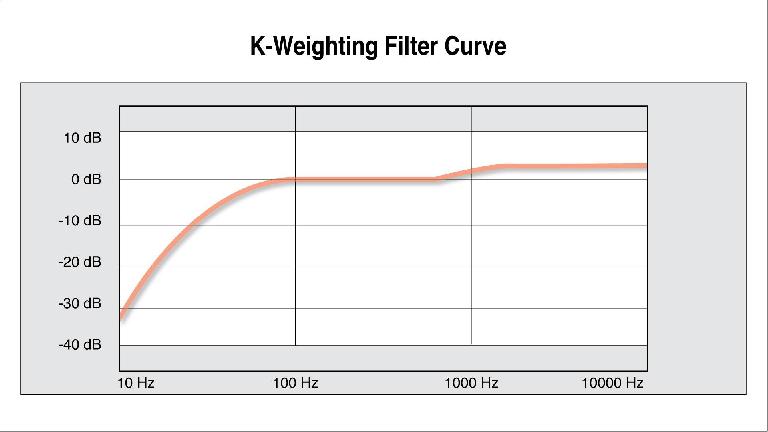
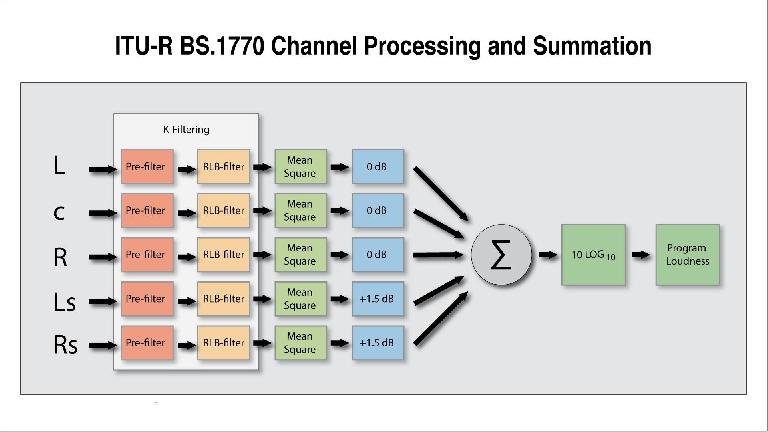

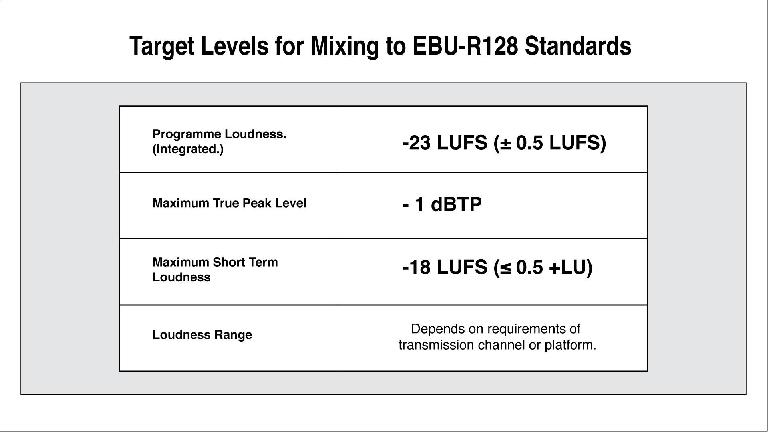
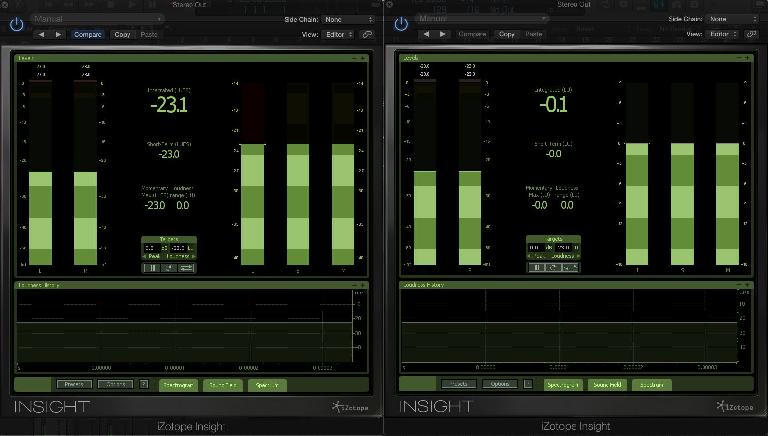


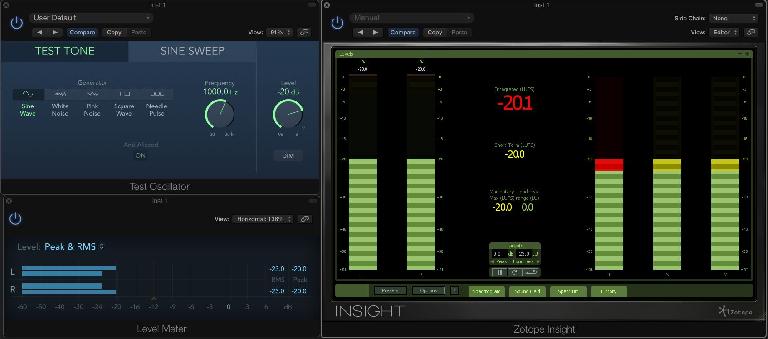

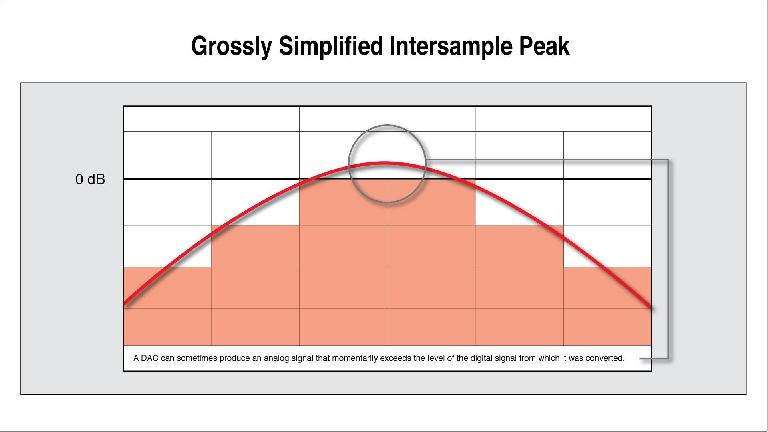
 © 2024 Ask.Audio
A NonLinear Educating Company
© 2024 Ask.Audio
A NonLinear Educating Company
Discussion
I have tried and used all the meters listed below, in some way, in a real world application/production, and give a brief outline of their strengths and weakness.
Anecdotally, the paid versions are by far easier to use, mostly because they offer the ability to re-size/re-scale the plug-in window, making the GUI easy to read off a second monitor; visibility is a deal breaker.
That said, the "free" options below are more than good enough to get started with measuring and meeting standards.
Free, "Free", registration required, bundled "try and buy strategy", and limited features loudness meters:
HOFA 4U Meter, Fader & MS-Pan (For me, slightly confusing GUI)
MELDA Production MLoudnessAnalyzer (Has to be downloaded with the whole Melda Package, which is not a bad thing.)
TBProAudio, dpMeter II (No reset button as far as I can find, an absolute necessity.)
Toneboosters, TB EBULoudness (saving parameters disabled)
Paid (recommended):
Izotope: Insight
A professional loudness meter with many additional metering features. Intuitive well designed interface, re-sizable/re-scalable, and highly configurable.
The manual is easy to follow, and covers all you would need to know about metering.
Klangfruend: LUFSMeter
My go to meter, highly configurable, re-sizable/re-scalable, accurate, and well supported.
It can be synched across many instances of the plug-in loaded in one project, and has a “level-to-target-loudness†gain function built in that makes loudness normalisation very easy.
It is possible to bounce audio through the plug-in for quicker analysis, meaning one does not have to sit through a full programme of material to get an Integrated loudness measurement.
The meter is marketed as "free" but is severely time limited to the point of being useless for real programme analysis, unless you pay for it.
The price is well worth the upgrade though, best value for money loudness meter on the market right now, and regularly updated to latest specifications.
Honorable mention: Span by Voxengo - NOT a loudness compliant meter but a great level metering plug-in nevertheless, and it is free.
For what it is worth, I am not affiliated with any of the companies mentioned here.
So, if I understood right, (I´m using the new Logic Loudness Meter) my master has to display a maximum -23 integrated LUFS in order to be considered TV ready? Maybe it´s because I´m deeply immersed in this loudness war by I find it extremely low...
By the way, what are your thoughts about the new Logic Loudness Meter?
Thanks again!
Marcos
Yes you are correct, the -23 LUFs target level is compliant with most TV standards around the world (-24 LUFS in some countries for technical reasons I won’t go into), you would still have to check with the channel or platform you plan to edit or mix for to be sure as some smaller stations and agencies might still using older standards in-house.
Yes -23 LUFs is low, and for the moment a target level of -16 LUFS for non TV related audio production seems to be gaining a foothold. -16 LUFs closely relates to the early days of average dynamic range in music produced before the loudness wars kicked in. iTunes averages individual tracks to -16 LUFS with soundcheck and Youtube seems to hover around -14 LUFS for some major content (low count videos are not loudness leveled as far as I can tell).
Regarding Logic meters (as of version 10.2.2): MultiMeter’s LU meter shows two loudness related readouts – LU-I: Integrated, which measures the average level over the course of an entire program, and LU-S: Short-Term, which measures loudness within 3-second periods.
It’s bare minimum for accurate metering, and the numbers are too small for quick reference. It also lacks a Loudness Range Value and a Loudness history graph which greatly aid in assessing where program material might be “going over†target levels.
Also be sure to set the meter to True peak and RMS because it is not default.
Curiously, Logic X RMS readouts are “off†by -3dB and there is no way to offset it that I know of. In Voxengo Span default dBFS meter is also off by -3dB but it is possible to set it to dBFS +3dB to get meter levels that match higher end meters.
To have true insight into your loudness levels I would suggest looking into getting an actual loudness meter from the list I provided in my reply to Dav’s comment above yours.
Best,
So, if I understood right, (I´m using the new Logic Loudness Meter) my master has to display a maximum -23 integrated LUFS in order to be considered TV ready? Maybe it´s because I´m deeply immersed in this loudness war by I find it extremely low...
By the way, what are your thoughts about the new Logic Loudness Meter?
Thanks again!
Marcos
I have just loaded some brand new MP3 tracks from Amazon's autorip and all of the albums I have tried are giving an integrated LUFS of around -10, which seems to be much higher than suggested. The tracks sound great, no pumping or distortion!
But if I master some of my own songs to -14 lufs they sound really quiet - compared to new releases.
To me it seems the LUFS guidelines are trying to lump all music together regardless of whether its a full band playing rock (which is what I do) or a solo singer and surely that isn't right: it also completely ignores that fact that some music just sounds better when pushed a bit!
So: how do you create a punchy in your face mix while adhering to the guidelines?
Thanks Keithwm, thankfully it is not all that complicated once you get the hang of it.
>There is a new free meter called Youlearn loudness meter and it seems pretty good .
Yes, the Youlean Loudness Meter is fantastic. I highly recommend it.
>However I am very confused about the LUFS scale and levels.
We need a support group, Loudness Anonymous or something. :)
>I have just loaded some brand new MP3 tracks from Amazon's autorip and all of the albums I have tried are giving an integrated LUFS of around -10, which seems to be much higher than suggested. The tracks sound great, no pumping or distortion!
This will happen a lot over the next few years. There's an enormous momentum behind the old school loudness paradigm, and even to this day many big artists and record labels are pushing for CD releases at so-called competitive loudness levels. There are tons of songs made to these pre loudness normalisation standards. As a good example one of my favourite artists, Andy Shauf, a gentle canadian singer songwriter, has a sterling album called The Magician, and it is a whopping -11 LUFS in some places, sounds fantastic though, but I am convinced it would work just as well at -16 LUFS.
>But if I master some of my own songs to -14 lufs they sound really quiet - compared to new releases.
This is now a game of short term versus long term gains. Look at it like this. ALL music that is going to be streamed will be loudness normalised at some point, invariably turned DOWN to a target level, most probably -16 to - 14 LUFS.
It is demonstrable that a loud hyper-compressed track turned down sounds weak and flat when loudness normalised next to a dynamic well mixed track – regardless of genre.
You can go louder and â€win†now, but you’ll “lose†later. Or you can “lose†for a short time now, mix to the new loudness paradigm, and then when everyone else is turned down, you are already at the finish line sipping cocktails.
>To me it seems the LUFS guidelines are trying to lump all music together regardless of whether its a full band playing rock (which is what I do) or a solo singer and surely that isn't right: it also completely ignores that fact that some music just sounds better when pushed a bit!
Remember the guidelines for -14 LUFS (et al) are “no louder than†targets, so if you are like me putting out self produced EPs of a few tracks at a time, then loudness normalising them to a fixed target makes sense (I use -16 LUFS personally), but if you are doing an album you may want to vary average loudness for artistic purposes and then have your “hit†or “single†be the “loudest†of that album (no more than -14 LUFS). i.e., not every song you do HAS to be -14 LUFS, but none should be louder – unless you want to be turned down anyway.
All that matters is that IF you do “compete†short term for loudness, then you and your “competition†will both be turned down and both flatten out later.
>So: how do you create a punchy in your face mix while adhering to the guidelines?
That, my friend, is the million dollar question!
I will close by pointing out that punchiness is about dynamics and not loudness in and of itself, so concentrating on dynamics and movement in the mix goes a long way.
Just for an experiment, try completely ignoring whether your track is loud enough. For a few days ditch any meters and just work with your music, no loudness targets, no LUFS, no RMS, just you, the mix and what you are trying to express, get back into the emotion of the songs , the original idea – make it work regardless of loudness, and see what happens.
I use Cakewalk Sonar and Tracktion. I inserted the Youlearn LUFS meter in my master fx slot and it read the levels. Then I adjusted the master and it still read the same levels, and then it hit me. On Sonar and Tracktion the FX slots on the master are pre fader. It actually means regardless of what you put in the FX (and I was inserting a maximizer with a -.1DB protection) the actual export of my recordings was set by the master and not the maximizer.
I wonder how many people this would catch out?
I can get around the meeting reading issue in Sonar using a post fader send bus, but that doesn't stop the master sending a level louder than my maximizer - I can just see it now!
that can tell us the actual numbers unless a digital+analogue solution......basically a real engineering audio hw n sw solution how it should be,,,,,,
Want to join the discussion?
Create an account or login to get started!